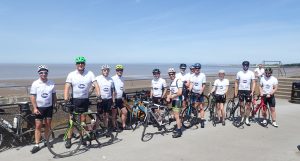When you cycle as a club member in a group with others, you will be riding very close to a number of other cyclists, at over 20 miles per hour, in moving traffic.
This has obvious safety implications.
“Ride Etiquette” describes the techniques and skills that cyclists have developed to let us all ride safely with each other.
If you have not ridden in a group before you should study ride etiquette before attempting your first group ride. And it would be good to book onto one of the club’s slower rides to practise riding in a group, and using these skills, before attempting a faster longer ride.
The Basics
For beginners the following three videos cover the basics well (sorry about the adverts and product placement). This is mostly about riding safely together.
- GCN – How to Ride in a Group – Group Riding Etiquette
- Improve Your Group Cycling Etiquette | Cycling Weekly
- GCN – How To Use Hand Signals Whilst Cycling | Essential Group Ride Communication For Bike Riders

As you get better you can finesse your skills. The advice here is common to most bike clubs. It is partly about safety, and partly about good manners, how to ride in a way that respects other riders needs.
- Maintain a steady straight line with no sudden movements. Be predictable with all your actions. Avoid braking or changing direction suddenly.
- Lead riders should use hand signals to indicate stopping or turning as well as clearly audible shouted instructions.
- Riders at the front and rear should warn of approaching cars, particularly on narrow roads. Call out for vehicles – shout “CAR FRONT!” & “CAR BACK!” Panicked cries are not necessary. Just shout loud enough for the person in front/behind to pass on the call.
- Point out and call out any road hazards ahead. These include potholes, drains, speed ramps, animals, parked cars, opening car doors, wet or icy road surface etc.
- Don’t overlap wheels. A slight direction change by the rider in front could easily catch you out. If you ‘touch wheels’ with the rider in front it’s tough to keep upright.
- Make sure to keep pedalling downhill when you are at the front of the group so that the riders behind don’t bunch up behind you. It can be a bit fraught if everyone has to reach for their brakes. Change into the big ring going downhill if conditions/speed require it.
- Be smooth with your turns at the front of the group. Avoid surges.
- If riding alongside another cyclist don’t increase the pace to move a half wheel ahead. He/she will then have to speed up to maintain the two-by-two formation and the speed of the entire group will escalate unnecessarily. Don’t acquire a reputation as a ‘half-wheeler’!
- Don’t sprint up to take your turn at the front. Move up smoothly with a small increase in pace and ease that pace back when you move back into the group.
- Avoid leaving gaps when following wheels. Cyclists save a huge amount of energy by following in the slipstream of the rider in front. However, don’t become mesmerized by the rear brake of the rider in front as you concentrate on staying close as there’s a good chance you’ll ride into it! Keep looking well ahead to spot hazards and terrain changes.
- Be considerate to other traffic when riding in a group. If the roads are wide enough, ride two abreast so the group is compact and easier to overtake. Ride single file on narrower roads, but think about group size. Long straggling groups will be hard for cars to overtake safely.
- When climbing hills, avoid following a wheel too closely. Many riders often lose their momentum when rising out of the saddle on a hill which can cause a sudden deceleration. This can often catch a rider who is following too closely, resulting in a fall from a wheel touch.
- Don’t panic if you brush shoulders, hands or bars with another rider. Try to stay relaxed in your upper body to absorb any bumps.
- Wear a helmet on all club rides and make sure your bike is in good working order.
- Use mudguards in winter as a courtesy to other riders.

